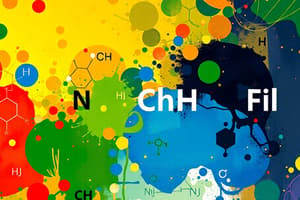Podcast
Questions and Answers
¿Cuál es el número de coordinación en un compuesto de coordinación si hay 4 ligandos unidos al ion central?
¿Cuál es el número de coordinación en un compuesto de coordinación si hay 4 ligandos unidos al ion central?
- 5
- 2
- 4
- 3 (correct)
¿Qué tipo de enlace se forma cuando los electrones se comparten entre átomos en compuestos covalentes?
¿Qué tipo de enlace se forma cuando los electrones se comparten entre átomos en compuestos covalentes?
- Enlace iónico
- Enlace covalente (correct)
- Enlace metálico
- Enlace de coordinación
¿Qué teoría se desarrolló para describir el comportamiento de iones de metales de transición en solución?
¿Qué teoría se desarrolló para describir el comportamiento de iones de metales de transición en solución?
- Teoría de Werner (correct)
- Teoría de Bohr
- Teoría de Mendeleev
- Teoría de Lewis
¿Qué representa el número romano en el nombre de un complejo metálico?
¿Qué representa el número romano en el nombre de un complejo metálico?
¿Cómo se denominan los compuestos formados por la unión entre un ion central y ligandos?
¿Cómo se denominan los compuestos formados por la unión entre un ion central y ligandos?
¿Qué tipo de compuesto se forma a partir del intercambio de electrones entre átomos enlazados en una estructura molecular?
¿Qué tipo de compuesto se forma a partir del intercambio de electrones entre átomos enlazados en una estructura molecular?
¿Cuál es la convención de nomenclatura para los compuestos iónicos?
¿Cuál es la convención de nomenclatura para los compuestos iónicos?
¿Cuál de las siguientes afirmaciones sobre los ácidos es correcta?
¿Cuál de las siguientes afirmaciones sobre los ácidos es correcta?
Si un ácido contiene el anión 'nitrato' (NO3-), ¿cómo se llama el ácido?
Si un ácido contiene el anión 'nitrato' (NO3-), ¿cómo se llama el ácido?
¿Cuál de las siguientes afirmaciones sobre los compuestos de coordinación es correcta?
¿Cuál de las siguientes afirmaciones sobre los compuestos de coordinación es correcta?
¿Cuál de las siguientes opciones describe correctamente a los compuestos covalentes?
¿Cuál de las siguientes opciones describe correctamente a los compuestos covalentes?
Si un compuesto contiene el ion 'sulfito' (SO3^2-), ¿cómo se nombra el ácido correspondiente?
Si un compuesto contiene el ion 'sulfito' (SO3^2-), ¿cómo se nombra el ácido correspondiente?
Flashcards are hidden until you start studying
Study Notes
Inorganic Nomenclature
The study of inorganic chemistry involves understanding various categories of compounds, including those containing ionic, covalent, transitions metals, and other forms of compounds. Each category follows specific naming conventions to ensure clear communication among researchers and students. In this article, we will explore the nomenclature systems for ionic compounds, acids and bases, transition metal complexes, coordination compounds, and covalent compounds.
Ionic Compounds
Ionic compounds are formed when ions, either cations (positive-charged ions) or anions (negative-charged ions), bind to each other via electrostatic forces. The ions can be derived from individual elements or polyatomic species. The naming convention for ionic compounds specifies the cation first, followed by the anion. The cation retains the same name as the element, while the anion's name is modified to end in "-ide". For example, the compound CaCl2 (calcium chloride) consists of a Ca2+ cation (calcium) and two Cl- anions (chloride).
Acids and Bases
Acids are compounds that release hydrogen ions (H+) when dissolved in water. Their names follow the "-ic" rule if they contain "ate", such as sulfuric acid (H2SO4) from the nitrate ion (NO3-) + H+ = nitric acid (HNO3). If the ion ends in "-ite", the acid name has a "-ous"ending, like nitric acid (HNO2) from the nitrite ion (NO2-) + H+ = nitrous acid (HNO2).
Transition Metal Complexes
Transition metal compounds contain transition metal ions (elements from groups 3 to 12 in the periodic table), which have the ability to exist in multiple oxidation states. The Roman numerals in the compound's name represent these varying charges. For instance, the complex Fe(SO4)3 (iron(III) sulfate) contains a Fe3+ ion combined with three SO42- anions.
Coordination Compounds
Coordination compounds, also known as coordination complexes, involve a central metal ion surrounded by ligands, which can be neutral molecules or ions. The coordination number refers to the number of ligands bound to the metal center. Werner's theory of coordination compounds was developed in the late 19th century to describe the behavior of transition metal ions in solution. It classifies the coordination environment based on primary valence, which describes the number of electrons involved in the bond formation, and secondary valence, which refers to additional interactions between ligands.
Covalent Compounds
Covalent compounds are formed from the sharing of electrons between atoms, resulting in non-ionic bonds. The nomenclature system for covalent compounds is different from that of ionic compounds. For example, ammonium nitrate (NH4NO3) follows the chemical formula for the compound and does not require conversion between ionic and molecular forms like other ionic compounds do.
In summary, the nomenclature system for inorganic compounds involves understanding various categories of compounds and their specific naming conventions based on their ionic or covalent nature, as well as the presence of transition metal complexes or coordination compounds. By following these guidelines, chemists can effectively communicate about the properties and behavior of these intriguing materials.
Studying That Suits You
Use AI to generate personalized quizzes and flashcards to suit your learning preferences.


